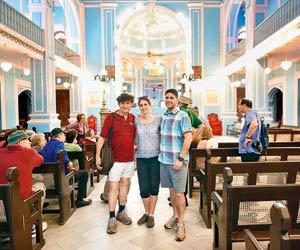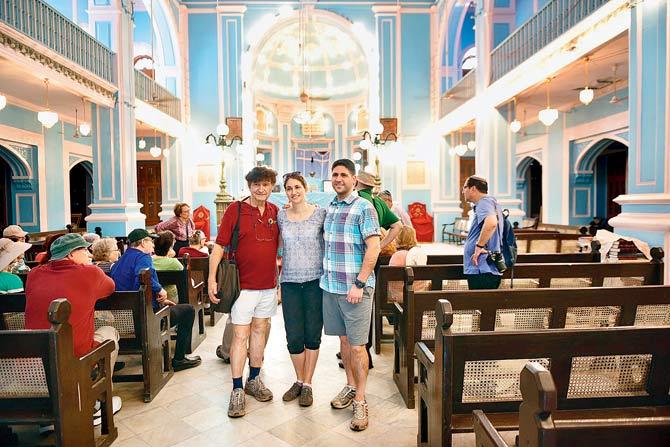A nostalgic trail with a Jewish scholar to trace his roots offered a glimpse into the cityu00c3u00a2u00c2u0080u00c2u0099s famous cosmopolitan fabric that salutes every community - big and small


Dr Saul Shapir and his children at the Magen David Synagogue, an over 150-year-old landmark in Byculla. Pic/Bipin Kokate
ADVERTISEMENT
 Last week, we were back to our wanderings in Byculla - a chaotic, buzzing neighbourhood that continues to fascinate us with its stories and people, seamlessly interwoven into layers of 'Bombayness' in its every corner and contour. We like to call it a microcosm of what the city represents for us, at least to some extent, especially in these rapidly changing times.
Last week, we were back to our wanderings in Byculla - a chaotic, buzzing neighbourhood that continues to fascinate us with its stories and people, seamlessly interwoven into layers of 'Bombayness' in its every corner and contour. We like to call it a microcosm of what the city represents for us, at least to some extent, especially in these rapidly changing times.
This character was evident from the start of our trail with Jewish scholar, Dr Saul Shapir. He was revisiting glimpses of his early life in the innards of Nagpada with his two children who had accompanied him from Israel on his visit.
The bell at Sir Jacob Sassoon High School [where he studied briefly] inside the Jewish Compound had just been rung, and its students, a mix of Hindu, Muslim and Christian, rushed out to play in the school ground. In no time, pillars of dust filled the morning air as they engaged in friendly banter over tug-of-war and chor-police.
We walked past the stunning Magen David Synagogue, the over 150-year-old landmark whose bell tower paints a striking picture in the Byculla skyline, along with Roman Catholic Gloria Church, barely 1.5 km away, and the Anglican Christ Church, which is a stone's throw away. On that day, the synagogue was packed with a busload of tourists -again, a mix of Indians belonging to different faiths, as well as foreigners.
As we proceeded towards the Nagpada Gate, the vast open space behind the Jewish place of worship caught the eye. It was being decorated for what was possibly the reception for a Hindu or Muslim wedding. The eyes of both his kids lit up on hearing about the wonderful mix of communities that were involved in this one-night project, the garishly opulent stage, and the sight of an open-air kitchen where hundies and bhurnies were being set up to cook a grand feast. “There will also be Bollywood-style dancing, no?” his daughter asked. We all broke into laughter.
Further down New Nagpada Road, the scholar pointed us to long-gone sites and decrepit buildings that once had Jewish owners and Muslim tenants who had to rely on Iranis cafes and Hindu vendors on a daily basis. His teachers were Anglo-Indians, while his school friends were Jews, Maharashtrians and Iranis. “It was wonderful. Now that's what you call community living,” he said, as we tried to imagine what life must have been like living in this neighbourhood in the 1950s and 60s.
A little further, he showed us the spot where the Khada Parsi statue once stood. “Plenty of Parsis lived here in those days and the corner buildings had cafés run by them. Now, they are all gone,” he recalled. Even for a resident Bombaywallah like us, it was turning out to be a terrific lesson. The two-hour-long walk with a Byculla-born, Jerusalem-based scholar reminded us of the true fabric of Bombay that we grew up around, and the one we hope, survives for the benefit of generations to come. For there will be no Bombay without its communities.
mid-day's Features Editor Fiona Fernandez relishes the city's sights, sounds, smells and stones...wherever the ink and the inclination takes her. She tweets @bombayana. Send your feedback to mailbag@mid-day.com
Download the new mid-day Android and iOS apps to get updates on all the latest and trending stories on the go
 Subscribe today by clicking the link and stay updated with the latest news!" Click here!
Subscribe today by clicking the link and stay updated with the latest news!" Click here!






